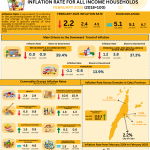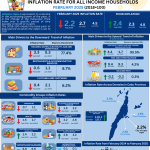Starting February 2022, the Philippine Statistics Authority (PSA) released the rebased Consumer Price Index (CPI) for all income households to base year 2018, from base year 2012 as announced in the press release number 2022-01 dated 04 January 2022. The CPI series for all income households for January 2022 onwards will be 2018-based.


A. The Philippines
The Philippines’ headline inflation or overall inflation slowed down further to 4.7 percent in July 2023 from 5.4 percent in June 2023. This is the sixth consecutive month of deceleration in the headline inflation and the lowest since March 2022 with an inflation rate of 4.0 percent. The average inflation rate from January to July 2023 stood at 6.8 percent. In July 2022, the inflation rate was recorded at 6.4 percent.
B. Central Visayas
Similar to the national trend, the inflation rate in Central Visayas slowed down further to 4.1 percent in July 2023 from 5.0 percent in June 2023. This is the fifth consecutive month of deceleration in the regional inflation and the lowest since January 2022. In July 2022, the inflation rate was recorded at 6.9 percent.
C. Province of Bohol
1. Headline Inflation
Inflation rate (IR) in Bohol continued its decline for the seventh consecutive month, dropping to 4.2 from 5.9 in June 2023. The inflation rate in July 2022 was higher by 3.4 percentage points. The average inflation for the last seven months of the year stood at 7.4 percent. (Table A and Figure 1)
In comparison to national and regional figures, Bohol’s IR in July is lower by 0.5 percentage points than the national IR, and higher by 0.1 percentage points than the regional IR. (Table A)
1.1 Main Drivers to the Downward Trend of the Headline Inflation
The continued downtrend was mainly brought by housing, water, electricity, gas and other fuels which recorded a lower inflation of 3.9 percent from 6.3 percent in the previous month. The heavily-weighted food and non-alcoholic beverages also pulled down the overall inflation during the month with a lower inflation rate of 6.8 percent from 8.1 percent in June 2023. The third main source of deceleration for the July 2023 inflation was restaurants and accommodation services, which registered slower inflation at 11.4 percent from 18.0 percent in the previous month.
In addition, the annual rates of the following commodities slowed down during the month:
a.Alcoholic Beverages and Tobacco, 9.4 percent from 12.8 percent;
b.Clothing and Footwear, 3.1 percent from 5.1 percent;
c.Furnishings, Household Equipment and Routine Household Maintenance, 4.8 percent from 6.0 percent;
d.Health, 5.0 percent from 6.7 percent;
e.Transport, -7.5 percent from -6.9 percent;
f.Information and Communication, 0.6 percent from 0.7 percent;
g.Recreation, Sports and Culture, 2.4 percent from 2.8 percent;
h.Personal Care, and Miscellaneous Goods and Services, 4.1 percent from 5.5 percent.
The commodity groups Education Services, and Financial Services either retained their previous month’s IR or had zero percent annual growth.
1.2 Main Contributors to the Headline Inflation
The top three commodity groups contributing to the July 2023 overall inflation of 4.2 percent were the following:
a.Food and non-alcoholic beverages with 62.1 percent share or 2.6 percentage points;
b.Housing, water, electricity, gas and other fuels at 19.8 percent share or 0.8 percentage points; and
c.Restaurants and accommodation services at 11.7 percent share or 0.5 percentage point.
2.Food Inflation
Food inflation decreased to 6.8 percent from 8.1 percent. In July 2022, Food inflation was lower at 6.0 percent.
2.1 Main Drivers to the Upward Trend of Food Inflation
Milk, other dairy products and eggs was the primary driver of the lower food IR with
8.8 percent in July 2023 from 14.8 percent in the previous month. This was followed by fruits and nuts with an annual increment of 0.0 percent during the month from 7.0 percent. Sugar, confectionery and desserts ranked third, recording a 19.9 percent inflation during the month from 28.7 percent in the previous month.
Lower year-on-year growth rates were also observed in the indices of the following food items:
a.Corn, 8.9 percent from 11.9 percent;
b.Flour, bread and other bakery products, pasta products, and other cereals, 9.0 percent from 16.3 percent;
c.Fish and other seafood, 0.6 percent from 0.9 percent;
d.Oils and fats, 0.9 percent from 8.0 percent; and
e.Ready-made food and other food products n.e.c., 6.1 percent from 8.5 percent.
On the other hand, higher inflation rates during the month were noted in:
a.Rice, 6.8 percent from 5.7 percent;
b.Meat and other parts of slaughtered land animals, 7.3 percent from 7.2 percent; and
c.Vegetables, tubers, plantains, cooking bananas and pulses, 20.1 percent from 18.5 percent.
2.2 Main Contributors to the Food Inflation
Food shared 58.3 percent or 2.45 percentage points to the overall inflation in July 2023. The following food groups were the top contributors to food inflation during the month:
a.Cereals and cereal products, with 42.6 percent share or 2.90 percentage points;
b.Vegetables, tubers, plantains, cooking bananas and pulses, with 21.2 percent share or 1.44 percentage points; and
c.Meat and other parts of slaughtered land animals with 14.4 percent share or 0.98 percentage points; and





Prepared by
VENUS P. GLORIA (Sgd.)
Statistical Analyst
Reviewed by
EMMANUEL B. GALAB (Sgd.)
Statistical Specialist II
Approved by
JESSAMYN ANNE C. ALCAZAREN (Sgd.)
Chief Statistical Specialist
PSA Bohol




